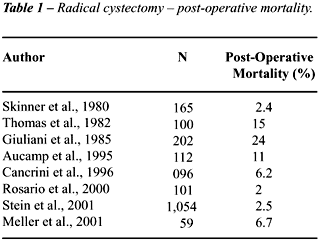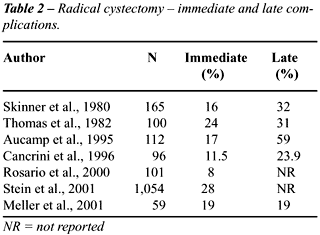COMPLICATIONS
IN RADICAL CYSTECTOMY PERFORMED AT A TEACHING HOSPITAL
(
Download pdf )
ALEX E. MELLER, LUCIANO J. NESRALLAH, MARCOS F. DALL’OGLIO, MIGUEL SROUGI
Division of Urology, Paulista School of Medicine, Federal University of São Paulo (UNIFESP), São Paulo, SP, Brazil
ABSTRACT
Objectives:
Radical cystectomy with urinary diversion has been the standard treatment
to infiltrative bladder neoplasms. We have analyzed a series of radical
cystectomies performed by residents at a school hospital and compared
the rates of complications in this series with those reported in literature.
Materials and Methods: During the period
of December 1996 to December 2000, 59 surgeries were performed by 8 residents
in our department, always oversaw by the same assistant. We have analyzed
age, gender, pathological staging, type of diversion used, surgical time,
need for blood transfusion and blood volume used during surgery, immediate
complications (1 to 30 days), late complications, and follow-up time.
Results: There were 51 men and 8 women.
Mean age was 61.3 years (28 to 89), and the majority of the group was
over 60 years (60%). Mean follow-up time was 8.5 months (3 to 36). Camey
II ileal neobladder was used in 36 (62%) cases, ureterosigmoidostomy in
8 (13.8%), Bricker in 12 (20.7%), and Mainz-Pouch II diversion in 2 (3.5%)
cases. Blood transfusion was required in 25 (42%) cases. Immediate complications
were observed in 19% of the patients, and late complications in 19% as
well.
Conclusion: When oversaw by an experienced
surgeon, a resident gathers the conditions to perform a radical cystectomy,
without significant increase in complication rates.
Key words:
bladder; bladder neoplasms; cystectomy; morbidity; postoperative complications
Int Braz J Urol. 2002; 28: 522-5
INTRODUCTION
Bladder cancer is the second most frequent genitourinary neoplasia, and transitional cell carcinoma responds for approximately 90% of the cases. Although the majority of patients has an initial diagnosis of superficial bladder cancer, 20 to 40% present infiltrative disease. Radical cystectomy with urinary diversion has been the standard treatment to invasive bladder neoplasms. Recent innovations of its surgical techniques, primarily related to the confection of orthotopic intestinal reservoirs and preservation of cavernous neurovascular bundles, with the technique described by Schlegel & Walsh (1), rendered the procedure more attractive to the patient, and much improved quality of life rates. The aim of this review is to analyze a series of radical cystectomies performed by residents in a school hospital, and to compare morbidity and mortality rates of this series to other presented in the literature.
MATERIALS AND METHODS
Design:
Retrospective study made by a review of charts of patients submitted to
radical cystectomy in the period of December 1996 to December 2000.
Participants: Fifty-nine surgeries were
performed in this period by 8 residents in our department, always oversaw
by the same assistant (LJN).
Surgical treatment: All patients underwent
radical cystectomy, bilateral iliac lymphadenectomy, according to the
technique previously published (2). Orthotopic ileal neobladder was the
diversion of choice for all patients for which urethral preservation was
possible and with normal renal function. For patients with tumoral invasion
of the urethra, we have performed a Leadbetter or Mainz II ureterosigmoidostomy,
and for patients with renal function impairment the diversion chosen was
cutaneous ureteroileostomy (Bricker).
Evaluation criteria: We have analyzed age,
gender, pathological staging, type of diversion used, surgical time, need
for blood transfusion and blood volume used during surgery, immediate
complications (1 to 30 days), late complications, and follow-up time.
RESULTS
There
were 51 men and 8 women in the group analyzed. Mean age was 61.3 years
(28 to 89), with the majority of the group over 60 years (60%). Mean follow-up
time was 8.5 months (3 to 36).
Histological types observed were: transitional
cell carcinoma in 52 (88.1%) patients, adenocarcinoma due to invasion
of colorectal tumors in 2 (3.4%), squamous cell carcinoma in 2 (3.4%),
and 3 (5%) sarcoma. There was squamous differentiation in 2 cases of transitional
cell carcinoma. The combination with carcinoma in situ occurred in 5 (9.6%)
cases and with prostate adenocarcinoma in 3 (5.7%) cases. Pathological
staging disclosed T0, Tis, and T1 in 8 (15.4%) cases, T2 in 21 (40.4%)
cases, T3 in 18 (34.6%) cases, and T4 in 5 (9.6%) cases. The remainder
includes adenocarcinomas, squamous cell carcinomas, and sarcomas.
Camey II ileal neobladder was used in 36
(62%) cases, ureterosigmoidostomy in 8 (13.8%), Bricker in 12 (20.7%)
and Mainz-Pouch II diversion in 2 (3.5%) cases. There was an intra-operative
decease due to acute myocardial infarction, and urinary diversion was
not performed. Mean surgical time was 326 minutes (255 to 420). Blood
transfusion was required in 25 (42.4%) cases, with a mean volume of blood
used of 785mL (500 to 1,200mL).
Immediate and late complications were observed
in 19% of the patients. Complications considered immediate included: metabolic
acidosis in 3 patients, acute renal failure in 1, surgical wound infection
in 1, pyelonephritis in 2, and abdominal wall dehiscence in 4 patients.
Late complications observed included unilateral hydronephrosis in 6 and
bilateral in 2 patients, pneumonia in 2 cases, and anterior wall necrosis
of the ileal neobladder in 1 patient, due to its incarceration in an incisional
hernia. Four (6.7%) deaths occurred during early post-operative period,
i.e., in the first 30 days after the surgical procedure. One patient presented
acute myocardial infarction, and 3 presented septicemia.
DISCUSSION
Our
results demonstrate that radical cystectomies performed by resident doctors,
under the supervision of an experienced surgeon, do not present higher
post-operative morbidity and mortality rates compared to the rates reported
in literature (3-9).
Improvement and systematization of surgical
techniques for radical cystectomy, enhancement of post-operative intensive
care, and increased antibiotic efficiency, have all contributed to the
drop in mortality reported in literature. This decreased from 29 to 54%
in the twenties, to 9 to 20% in the sixties, and to 1 to 8% in the eighties
and nineties. Mortality observed in this review was 6.7%, similar to other
radical cystectomies series (Table-1).

Aucamp & Heyns (6) analyzed 112 cases
operated in faculty departments, and reported that mean blood transfusion
volume requirement was 1.200mL of packed red cells. Rosário et
al. (8) reported that more than half of the patients received more than
4 units of packed red cells. When we compare this to our results, we observe
that the maximum volume of packed red cells transfused was 3 units (1,200mL);
mean transfused volume was 785mL in 25 patients (42.4%), and 57.6% of
the patients did not require transfusion. We consider the systematization
of the cystectomy technique (2) an important factor to control per-operative
bleeding.
Main post-operative morbidity observed in
this series was abdominal wall dehiscence in four patients, probably due
to their impaired nutritional status. Resuture of the abdominal wall was
required for these patients, and other immediate post-operative complications
observed were clinically treated. When we compare to immediate complications
related in the literature, we observe that they happened in 8 to 28% of
the patients (Table-2), showing no morbidity increase in major surgeries
performed by training surgeons under the supervision of a surgeon already
familiar to the procedure. We did not observe any difference in immediate
morbidity incidence, neither in per-operative bleeding between the different
types of diversion used. Despite our patients’ follow-up being shorter
than that of other series, the incidence of late complications is also
similar to those reported in the literature.

CONCLUSION
We have concluded that, when oversaw by an experienced surgeon, a resident gathers the conditions to perform major procedures, such as radical cystectomy, without a significant increase in complications rates.
REFERENCES
- Schlegel PN, Walsh PC: Neuroanatomical approach to radical cystoprostatectomy with preservation of sexual function. J Urol. 1987; 138:1402-6.
- Srougi M, Sakai AT, D’Império M: Cistectomia radical. In: Srougi M, Simon SD (eds.), Câncer urológico, São Paulo: Platina 1990; 255-80.
- Skinner DG, Crawford ED, Kaufman JJ: Complications of radical cystectomy for carcinoma of the bladder. J Urol. 1980; 123:640-3.
- Thomas DM, Riddle PR: Morbidity and mortality in 100 consecutive radical cystectomies. Br J Urol. 1982; 54:716-9.
- Giuliani L, Gilberti C, Martorana G, Bonamini A, Natta GD, Rovida S: Results of radical cystectomy for primary bladder cancer. Urology 1985; 26:243-8.
- Aucamp JW, Heyns CF: Surgical complications of radical cystectomy in a teaching hospital. S Afr J Surg. 1995; 33:31-8.
- Cancrini A, De Carli P, Pompeo V, Fattahi H, Lamanna L, Giuseppe C, et al.: Lower urinary tract reconstruction following cystectomy: experience and results in 96 patients using the orthotopic ileal bladder substitution of Studer et al. Eur Urol. 1996; 29:204-9.
- Rosario DJ, Becker M, Anderson JB: The changing pattern of mortality and morbidity from radical cystectomy. Br J Urol. 2000; 85:427-30.
- Stein JP, Lieskovsky G, Cote R, Groshen S, Feng AC, Boyd S, et al.: Radical cystectomy in the treatment of invasive bladder cancer: long-term results in 1054 patients. J Clin Oncol. 2001; 19:666-75.
_____________________
Received: August 6, 2002
Accepted after revision: October 21, 2002
_______________________
Correspondence address:
Dr. Luciano J. Nesrallah
Rua Barata Ribeiro, 414 / 25
São Paulo, SP, 01308-000, Brazil
E-mail: nesrallahuro@uol.com.br